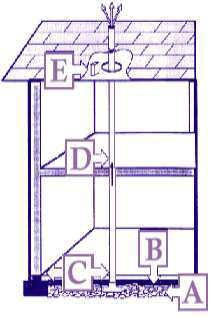Radon causes an estimated 14,000 lung cancer deaths each year. It is the earth's only naturally-produced radioactive gas and comes from the breakdown of uranium in soil, rock, and water. You cannot see or smell radon, but it can become a health hazard when it accumulates indoors. It can enter your home through cracks and openings in the foundation floor and walls. When radon decays and is inhaled into the lungs, it releases energy that can damage the DNA in sensitive lung tissue and cause cancer.
Why Buy A Radon-Resistant Home
- The techniques work - Simple and inexpensive techniques reduce radon levels on average by 50%. The techniques may also lower levels of other soil gases and decrease moisture problems.
- It's cost effective - Building in the features is much cheaper than fixing a radon problem later.
- Save money - The techniques described here also make your home more energy efficient and could provide you an average of $65 savings per year in your energy costs.
- Upgrading is easy - If high levels of radon are found, a fan can easily be installed as part of the system for further radon reduction.
What are Radon-Resistant Features
 The techniques may vary for different foundations and site requirements, but the basic elements are:
The techniques may vary for different foundations and site requirements, but the basic elements are:
A - Gas Permeable Layer - This layer is placed beneath the slab or flooring system to allow the soil gas to move freely underneath the house. In many cases, the material used is a 4-inch layer of clean gravel.
B - Plastic Sheeting - Plastic Sheeting is placed on top of the gas permeable layer and under the slab to help prevent the soil gas from entering the home. In crawlspaces, the sheeting is placed over the crawlspace floor.
C - Sealing and Caulking - Al openings in the concrete foundation floor are sealed to reduce soil gas entry into the home.
D - Vent Pipe - A 3 or 4 inch gas-tight or PVC pipe (commonly used for plumbing runs from the gas permeable layer through the house to the roof to safely vent radon and other soil gases above the house.
E - Junction Box - An electrical junction box is installed in case an electric venting fan is needed later.
What Can You Do?
Simple, inexpensive techniques can be used to lower radon levels and increase energy efficiency in your new home. Here are basic steps to follow when buying a new home.
- Check Your Area's Radon Potential - Find out if you are buying a home in a high radon area. The Environmental Protection Agency's map of radon zones shows which areas have the greatest potential for elevated indoor radon readings. Homes in places with high radon potential, called Zone 1 areas, should be built with radon-resistant features.
- Install a Radon Reduction System - Talk to your builder about installing a radon reduction system. You can obtain free copies of the EPA's Model Standards and architectural drawings and use them to explain the techniques to your builder. Let your builder know that the radon resistant features can be easily installed with common building practices and materials.
- Remember: Test Your Home - Every new home should be tested for radon after occupancy. Test your home even if it has the radon resistant features. Test kits are inexpensive and may be purchased at your local hardware store. Or simply call the National Safety Council Radon Hotline at 800-SOS-RADON to order a test kit.
- If Radon Levels Are Still High, Activate - If your home tests at 4.0 picocuries per liter (pCi/L) or above, activate the system by installing an in-line fan. Call a local radon mitigator about installing the fan. Check with your state radon office for names of qualified or state certified radon contractors in your area.
Need More Information?
Many publications are available to you. Here are just a few suggestions:
- Home Buyers and sellers Guide to Radon.
- EPA's Map of Radon Zones.
- Model Standards and Techniques for Control of Radon in New Residential Buildings, developed by the U.S. Environmental Protection Agency, and the building industry with details on how to install radon-resistant techniques in your new home.
- Architectural Drawings of Radon Resistant Construction Techniques.
You can find this information at the National Service Center for Environmental Publications (NSCEP website) or call 800-490-2300.
In addition, you can order the One and Two Family Dwelling Code, Appendix F which provides details on radon-resistant techniques, by contacting the Council of American Building Officials at 708-799-2300. You can also order a kit to explain to your builder the radon resistant techniques from the National Association of Home Builders. Call the Home Builder Bookstore at 800-223-2665 and order "Building Radon Resistant Homes: A Builder's Independent Study Kit."

